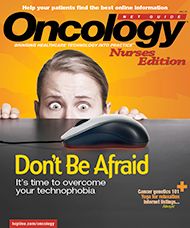Publication
Article
ONCNG Oncology Nursing
4 Questions... with Donna DuLong, RN, BSN, Independent Consultant and Co-Chair, Logistics Committee, TIGER Initiative
Author(s):
DuLong explores the Technology Informatics Guiding Educational Reform (TIGER) Initiative, why it is so popular among many organizations, and how it can impact the healthcare industry.
1 Why is it important for nurses to use technology in their medical practice?
DuLong explores the Technology Informatics Guiding Educational Reform (TIGER) Initiative, why it is so popular among many organizations, and how it can impact the healthcare industry.
The reality is that every aspect of nursing practice and education will be aff ected by computerization, if it hasn’t been already. It’s hard to imagine a nurse working without a stethoscope today, but 50-60 years ago, that was new, unheard of technology. We can’t imagine a nurse successfully delivering patient care without some aspect of computerization or technology. Everything is impacted by technology, but rather than waiting for that to happen, we can help shape it; we can help identify what technologies enable better patient care and more patientcentered care.
2 How did the TIGER Initiative begin?
It started when President Bush created the Office of the National Coordinator for Health Information Technology in 2004 and put David Brailer in that position. David Brailer started a committee to fi gure out if we were going to use technology to reform healthcare and what we’d need to put it in place. He had several meetings and met with a number of people to develop the plan, but there wasn’t a single nurse involved. We feel pretty strongly that because nurses make up more than half of the healthcare workforce, we should be at the table discussing healthcare reform and the kind of healthcare IT architecture that needs to be in place. I think nurses aren’t always at the table, because it’s a little confusing knowing who to contact. There are so many specialty organizations—nurses are pretty diversifi ed as a whole, so it’s hard to know where to go to get opinions. We feel that we could have organized nursing as a whole to weighin on what we thought healthcare IT meant to us. This is why we organized the summit and invited all of the major nursing organizations to participate. We were looking beyond the typical nursing informatics organizations. We wanted to represent nursing as a whole and felt that the critical people in providing a common vision and feedback were all of the nursing professional organizations.
3 Why do you think so many organizations became interested in working on this grassroots project?
One of the major hurdles of any topic is that it can be too focused on one specialty, like the nursing informatics community, which has been concerned about how we are going to prepare the nursing workforce for technology. If this doesn’t matter to everyone in nursing, nothing’s really going to change. Our goal was to hold the conference and develop and publish the action plan. Since then, we’ve received additional funding to continue to move the conversation forward and continue to try to disseminate the plan. The reality is that we didn’t want to start a new organization and didn’t want to compete with any of the alreadyestablished organizations. We just wanted to help facilitate communication to those professional organizations so that they can communicate the message to their members. We wanted to keep it a collaborative effort amongst professional organizations and anyone interested in participating. If it’s not adopted by all of the practicing nurses, it won’t be successful.
4 How will the TIGER Initiative impact the healthcare industry?
Our hope is that these messages will resonate within nursing and we can change what is needed in the education of nurses so that they have better baseline skills to use technology and computerization. We’ve had a big impact in the academic area. The National League for Nursing (NLN) has created a position statement requiring computer literacy and informatics skills to be part of the curriculum for graduating nurses. For NLN to certify the schools, they will have to include it in their curriculum. The other group associated with credentialing, the American Association of Colleges of Nursing (AACN), has also rewritten its essentials for baccalaureate education. They are including requirements for informatics skills too, so that graduating nurses will have skills or will be developing them. We’re trying to publish minimum competencies to work with organizations that facilitate professional or staff development to bring the existing nursing workforce up to speed. Technology is aff ecting the way we all practice, so we need to make sure that nurses have the skills to be successful.
